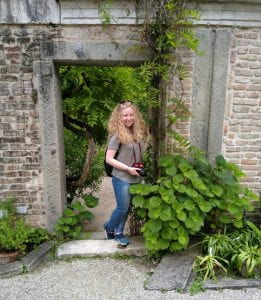Check out the following research story from fellow UHPer Mark Thomas-Patterson!
This semester, I took part in the GW Institute of Korean Studies Undergraduate Research Fellowship. This is a program sponsored by the GWU Institute of Korean Studies in which participants propose to write an academic article on any topic that connects with Korea. You are then matched up with a professor who focuses on that area of study, in my case Professor Greg Brazinsky in the Elliott School. Participants them work with their mentor towards creating a final paper, and workshop with other members of the program. Finally, the fellows with the top five papers are chosen to present at a research symposium with students in a sister program and Indian University. Even though the symposium was cancelled, I ended up being awarded the third-place award for my paper.
For this project, I analyzed how the Chicago Tribune, then a prominent conservative publication, covered the South Korean leader Syngman Rhee, a GWU alum who would later go on to be the first president of South Korea in the years between 1945-1950. I chose this topic as I am interested in the history of international relations and am particularly interested at how domestic groups viewed foreign affairs.
In order to understand why I decided to analyze the Chicago Tribune in this time period, one needs to understand the state of US conservatism in the 1940s. Unlike conservatism of today, conservatism of the 1940s was split between both parties, and drew on supporters from all around the country. However, conservatives at the time had a few major defining ideals. One of these was Anti-Communism. Conservatives, ever since the Bolshevik Revolution in Russia in 1917, had opposed the spread of Communism and sought to combat it. During the 1920s and 30s many American conservatives had attacked organized labor for being the vanguard of communism in the US. Another ideal shared by many conservatives, as well as many on the left, was the belief in isolationism. American conservatives did not seek to create a state in which the US would turn into some sort of hermit kingdom a la DPRK. Instead, there was a belief that the US should not seek military involvements overseas.
An Overview of the Chicago Tribune
The Chicago Tribune represented the Midwestern conservative branch of the Republican party under the ownership of Col. Robert McCormick(who was never a Col.). McCormick was the descendant of Cyrus McCormick and inherited the International Harvester company. He utilized these funds to go purchase the Chicago Tribune and turn it into a mouthpiece to advocate for his own political beliefs, which included supporting relatives who were active in the Republican party. This blatant bias in the paper granted it a certain degree of journalistic infamy, with a survey of journalists declaring the paper the most biased in the country, a title it shared with the newspaper of the US Communist Party. The paper had a long list of enemies, including the Roosevelt administration and organized labor. It was incredibly isolationist and intensely criticized Churchill and Stalin, who were displayed as European imperialists intent on manipulating the US.
Phase One- A Useful Friend
The Chicago Tribune’s coverage of Rhee can be broken into three main phases. The Tribune’s coverage of Syngman Rhee began at the San Francisco conference of 1945, where Rhee had traveled to advocate for recognition of his Korean Provisional Government in exile, as Korea was still under Japanese rule. Rhee’s application for Korea to join the brand-new United Nations was turned down by the US State Department as they had a policy of not recognizing any formally established governments. The Chicago Tribune noticed this and reached out to Rhee. Rhee talked to the Tribune about how he sought to create an independent Korean state based on American principles of Republican government and free enterprise. This connection was in large part motivated by the fact that the Tribune wanted to criticize the Truman administration, and the saga of a Democratic adminstration ignoring the pleas of a pro-American freedom fighter made for a great story. This relationship is not entirely one sided, however, as Rhee wrote the Tribune, thanking it for its advocacy on his behalf.
Phase Two-Critique of an Authoritarian
The second phase takes place in 1946 and 47, when the Tribune correspondent Walter Simmons arrives in Southern Korea, which was under US military governance. Simmons painted Rhee as a diehard anti-communist, whose refusal to work with anyone on the left made him a major thorn in the side of the US military, who wanted Korea to have a functioning government. Simmons covers how Rhee uses paramilitary groups to attack newspapers that disagree with him, and states that he is an aspiring autocrat. This period is topped off by a report by Col. McCormick on the peninsula, in which he states the US should leave the peninsula, even if it means Korea will come under Soviet domination.
Phase Three- Anti-Communist Embrace
The last stage of the Tribune’s coverage of Rhee began in 1948 in the run up to the first Korean Presidential election. Here, the coverage of Rhee swings back in his favor. He is depicted as a dependable US ally seeking to create a country based off of American principles. Furthermore, the atrocities committed by right-wing paramilitaries were minimized, and the blame for all violence is placed on communists. The paper excuses Rhee’s repressive actions as necessary in order to counter the communist threat.
Throughout my research, I saw the Chicago Tribune at a crossroads in the history of American conservatism. At times, it signaled its isolationist tendencies, but in the end its desire to combat communism won out. This desire to support anti-communism abroad would later go on to define American conservatism throughout the rest of the Cold War.



